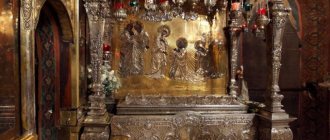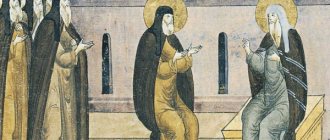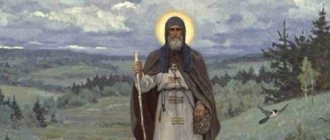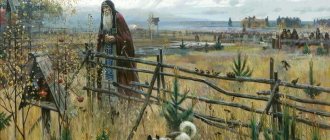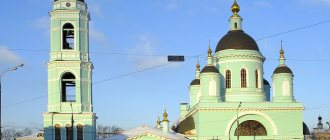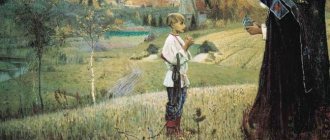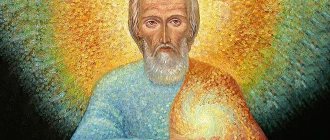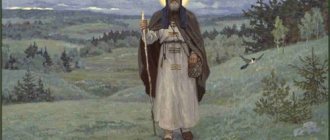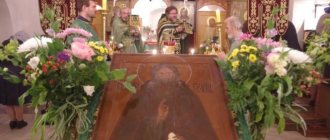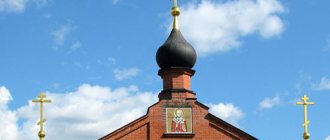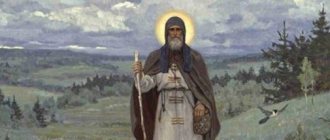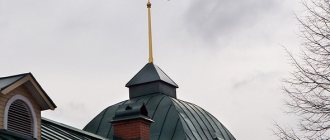In Christianity, there are a huge number of Orthodox shrines, each of which is known for its healing and other magical properties. It may happen that a person simply has no one to turn to for help and his only consolation will be prayer in front of the icon.
In this material, I invite you to familiarize yourself with the icon of Sergius of Radonezh and find out what problems it can help you with.
Historical information about the icon of Sergius of Radonezh
In Russian Orthodoxy, Sergei of Radonezh is a very respected and revered saint. The life of St. Sergius occurred in the fourteenth century; the saint completely devoted it to the service of God. His life was pious, observing all the Biblical commandments.
Fasting was very important for Sergius of Radonezh; he also monitored the fulfillment of God's commandments, setting an example for other believers with his life. The saint considered laziness to be the most terrible vice, so he worked hard until old age. He also showed kindness towards all people and tried, if possible, to help everyone who needed it.
In his early years, Sergius of Radonezh once went alone into the forest. Far from city life and people, he built himself a house in which he lived for a long time, fervently praying to the Creator every day. In his prayers, Sergius asked the Lord to help protect the Russian lands and support the Russian people.
The saint was more than once offered to work in the Russian metropolitanate, but he showed contempt for political life. He preferred to lead a purely solitary life, engaged exclusively in serving the Lord.
During his life, the monk was able to provide his help to a huge number of people, awakened in them faith in God and provided his support during a difficult period of time. His such strong devotion to the Creator and unshakable faith ensured him the love of Orthodox Christians and the respect of the church. Therefore, posthumously Sergius of Radonezh was awarded the title of saint.
Trinity Sergius Lavra
Since then, Bartholomew found his cherished dream: to become a monk, to devote himself to Almighty God. At first he helped his parents, and when they grew old and died, he went to the monastery, and there, with the blessing of the abbot, into the forests to live alone - in the “desert” - and pray to the Lord for the whole world. Sometimes, in order to receive Holy Communion and resolve everyday issues, he visited the monastery. People saw how kind he was, how he believed in the Lord and was ascetic. Many people began to come to Bartholomew, who had taken monastic vows with the name Sergius and the priesthood. He introduced a communal rule - everyone who came to the monastery divided property among themselves, lived on donations, and Saint Sergius himself took the least for himself.
Soon the princes began to come to the monk. He gave wise advice to everyone, called for a virtuous Christian life, and reconciled those leading internecine warfare. It was he who blessed Prince Dimitry Donskoy, also later glorified as a saint, for the battle on the Kulikovo Field.
Now his monastery has grown into the great Trinity-Sergius Lavra.
What does the icon of Sergius of Radonezh represent?
According to tradition, the shrine shows us the face of the saint himself, depicted either in full height or at waist level. A monastic robe is thrown over Sergius's shoulders. As a rule, the novice’s cassock is painted black or red.
Often, with the help of his left hand, the holy elder holds an unfolded manuscript, which acts as a symbol of the thirst for knowledge. And the second hand gives the blessing of Sergius to all believers with a gesture.
The entire image of the saint is designed to develop in people fortitude, devotion to faith, meekness and zeal. Just one look at the shrine allows you to overcome pride and improve spiritually, starting to actively improve yourself.
What does Sergius of Radonezh help with?
The face of the saint is incredibly popular: a lot of people regularly turn to him and he often demonstrates his miraculous power to the laity. If you turn to the icon sincerely, so that the prayer comes from the very heart, then it will definitely be heard by the Higher Powers.
In what situations can this image help you?
- The saint is asked for help in resolving problems related to studies.
- In addition, prayers to Sergius of Radonezh make it possible to most easily and harmoniously deal with various legal cases, but exclusively righteous ones. The Holy Elder protects from the attacks of offenders and gives enough strength to defend one’s rights.
- With the help of prayer requests, it is possible to pacify your violent temper and eliminate such a negative human vice as pride.
- You can also ask St. Sergius of Radonezh to heal you or your family and friends from any pathologies.
- Appeals to the image of the righteous protect against various difficulties and facilitate the process of getting out of difficult life situations.
- It is considered popular to turn to an image in order to improve your work affairs and get what you want.
- Another purpose of prayers to Sergius of Radonezh is to receive the necessary support, protection and find peace of mind.
Of course, it is permissible to read prayers at the image not only for yourself personally, but also for your close circle - relatives, friends and even enemies.
Help from the Holy Face
Peering at the image, reflecting on the life of the elder, the Orthodox believer subconsciously analyzes his actions. Every Christian understands the difference between his own activity and the ascetic existence of a saint. A person mentally shames himself and tries to somehow cleanse his sinful worldview.
- Prayer before the icon of Sergius of Radonezh helps a person acquire knowledge. The chronicle claims that the monk acquired the ability to read and write after meeting a mysterious monk, although previously the young man had been completely unable to do so.
- The holy image will help in pacifying and admonishing disobedient children.
- A miraculous image can relieve pride and impatience.
- Prayers help against negative external influences, enemy intrigues and everyday discord.
- The elder becomes the patron saint of all men named Sergei, and also protects orphans and women who have lost their husbands.
- During his lifetime, the saint cast out unclean spirits, healed the weak and resurrected people. There are many descriptions of posthumous miracles; this attracts a large number of Orthodox Christians to the icons and relics of the saint.
The effect occurs after some time. A believer needs to understand that God tests the strength and willpower of the one asking. Neophytes, praying in front of an icon, may feel a great loss of strength, so it is necessary to take into account: any spiritual activity requires colossal diligence. A uncomfortable state is natural if a person has not developed a habit.
When reading a prayer, a person must adhere to those texts that are well known to him. You are allowed to add only the essence of the request in your own words. It is better to pray daily than once a week, but for a long time.
Advice! A believer should not reproach himself for physical weakness in divine matters. The chronicles claim that even holy people experienced fatigue, and everyone needed rest. Even lying on his bed, a person is able to read prayers and receive help from the Almighty.
Who else can you pray to about studying:
- Prayer to Matrona of Moscow before the exam
- Prayer to Nicholas the Wonderworker for studies
- Prayer before the start of the school year
Overview of celebration days
The Church has designated four official days per year when the memory of His Holiness Sergei of Radonezh is honored in Orthodox churches.
- The first day is the eighth of October (according to the old calendar - the twenty-fifth of September). This number was not chosen by chance and serves as the date of death of the saint.
- The second date - the eighteenth of July (identified with the fifth of July according to the old calendar) - is also a special date for all those who adhere to Orthodoxy - it was on this day that the relics of St. Sergius were found.
- The fifth of June (or the twenty-third of May) is the third date for honoring the memory of the saint by Christians. Every year on the fifth of June, according to tradition, it is customary to remember all the clergy who adhered to the righteous path in the Rostov-Yaroslavl lands. Among them is Sergius of Radonezh.
- The fourth date concerning the Holy One falls on the nineteenth of July (the old calendar associates it with the sixth of July). The date is known as "Day in honor of the Radonezh Cathedral." It falls on the next day after the relics of Sergius were found.
History of the icon
Sergius of Radonezh, one of the most revered and beloved Russian saints by Orthodox Christians, left an indelible mark on the history of Rus'. His role is evidenced by the fact that the first icon of Sergius of Radonezh was painted at the beginning of the 15th century, that is, almost immediately after his death in 1392.
As a child, the youth Bartholomew, as the saint was named at baptism, perceived teaching very poorly, but after a miraculous meeting with a certain monk, an amazing transformation took place in him, and he began to excel in teaching.
Upon its completion, the pious young man went into the desert to lead a hermit’s life. He was about 20 years old when he took monastic vows under the name Sergius, which later glorified him throughout Rus'. Gradually, the brethren began to gather around Sergius, and together they founded a monastery, now called the Trinity-Sergius Lavra. This marked the beginning of the founding of many monasteries: Sergius and his disciples created about forty of them.
With his righteous life and gentle nature, Sergius of Radonezh earned the reputation of a peacemaker - he managed to reconcile the princes who were at war with each other and achieve their unity around the Moscow prince Dmitry
This played a decisive role in the victory of the Russian army in the Battle of Kulikovo, for which Sergius personally blessed Prince Dmitry, as the icon of Sergius of Radonezh “Battle of Kulikovo” tells.
Already in his old age, the monk experienced a great shock from the miracle described by the icon “The Appearance of the Mother of God to Sergius of Radonezh”: the Mother of God herself appeared to him and promised her continued protection.
Today, the icon of St. Sergius of Radonezh is in almost every Orthodox church, and many have it at home. In order for this saint to become the intercessor and heavenly patron of the boy named Sergei, it is necessary to give him an icon of St. Sergius of Radonezh.
The Monk Sergius of Radonezh reposed peacefully on September 25 (October 8), 1392. Exactly 30 years later, his relics were discovered, and today they are kept in the Trinity-Sergius Lavra near Moscow.
Trinity Monastery: 1355
Over time, with the blessing of the Patriarch of Constantinople Philotheus, a communal charter was introduced in the monastery of St. Sergius of Radonezh in 1355. The territory of the monastery was divided into three parts - public, residential and defensive. In the center of the monastery stood the new wooden Church of the Holy Trinity. The previously mentioned abbot Mitrofan first became the abbot of the monastery, and after his death - the Monk Sergius of Radonezh.
Soon the Trinity Monastery, supported by the great princes, began to be considered the center of the Moscow lands. It was here that the Monk Sergius of Radonezh blessed the army of Dmitry Donskoy for victory in battle with the horde of Mamai.
The Battle of Kulikovo took place on the birthday of the Mother of God, September 8 (September 21, new style), 1380. The date was not chosen by chance, because the Mother of God herself was the patron of Rus'. The monks of the Trinity Monastery Peresvet and Oslyabya, who had received the blessing of St. Sergius, entered the battlefield; they were once glorious warriors in Dmitry’s squad.
This was the sacred duty of every Orthodox Christian. The victory was won, many brothers died in those days. After the battle, Dmitry Donskoy came to the Trinity Monastery to personally notify Father Sergius of the victory.
There is such an extraordinary miraculous icon of St. Sergius of Radonezh, where he blesses Prince Dmitry Donskoy for the Battle of Kulikovo. This icon can heal diseases and protect real warriors from injury and death.
A little about the icon and relics of Sergius of Radonezh (Trinity-Sergius Lavra)
One amazing case is known regarding the discovery of relics. When the saint died, construction of a new church began at the monastery. And when this process was in full swing, one parishioner saw Sergius himself. The Christian reported this in the temple and said that the saint was asking to remove his body from the water and earth.
The monks did not ignore the saint’s request. And when the coffin was lifted up, it turned out that there was indeed water in it. But what most impressed everyone around was that despite the fact that the holy elder died thirty years ago, his body and clothes were preserved in completely original form.
Subsequently, pilgrims from all over the globe began to come here to touch and see this amazing shrine with their own eyes. For some, the relics of Sergius provided physical assistance, and for others, spiritual assistance.
Other faces with the relics of the saint can be seen in a large number of Moscow churches.
Venerable Sergius of Radonezh, abbot
In the first half of the 14th century, the famous Trinity-Sergius Lavra arose. Its founder, the Monk Sergius (in the world Bartholomew, 1314-1392), was the son of the Rostov boyars Cyril and Maria, who moved closer to Moscow to the village of Radonezh. At the age of seven, Bartholomew was sent to learn to read and write. He longed for learning with all his soul, but literacy was not given to him. Grieving over this, day and night he prayed to the Lord to open the door of book understanding to him. One day, while looking for missing horses in the field, he saw an unfamiliar old monk under an oak tree. The monk prayed. The youth approached him and told him his grief. Having listened sympathetically to the boy, the elder began to pray for his enlightenment. Then, taking out the reliquary, he took out a small piece of prosphora and, blessing Bartholomew with it, said: “Take, child, and eat: this is given to you as a sign of the grace of God and the understanding of the Holy Scriptures.” This grace really descended on the boy: the Lord gave him memory and understanding, and the boy began to easily assimilate book wisdom. After this miracle, the desire to serve only God became even stronger in young Bartholomew. He wanted to retire, following the example of the ancient ascetics, but his love for his parents kept him in his family.
Bartholomew was modest, quiet and silent, was meek and affectionate with everyone, never got irritated and showed perfect obedience to his parents. Usually he ate only bread and water, and on fasting days he completely abstained from food. After the death of his parents, Bartholomew provided an inheritance to his younger brother Peter and, together with his older brother Stefan, settled ten miles from Radonezh, in a deep forest near the Konchyura river. The brothers cut down the forest with their own hands and built a cell and a small church. A priest sent by Metropolitan Theognostos consecrated this church in honor of the Holy Trinity. This is how the famous monastery of St. Sergius arose.
Soon Stefan left his brother and became the abbot of the Epiphany Monastery in Moscow and the confessor of the Grand Duke. Bartholomew, tonsured a monk with the name Sergius, labored alone in the forest for about two years. It is impossible to imagine how many temptations the young monk endured at this time, but patience and prayer overcame all difficulties and devilish misfortunes. Whole flocks of wolves ran past the cell of St. Sergius, and bears also came, but not one of them harmed him. One day the holy hermit gave bread to a bear that came to his cell, and from then on the beast began to constantly visit St. Sergius, who shared his last piece of bread with him.
No matter how hard Saint Sergius tried to hide his exploits, the fame of them spread and attracted other monks to him, who wanted to be saved under his leadership. They began to ask Sergius to accept the rank of priest and abbot. Sergius did not agree for a long time, but, seeing in their persistent request a calling from above, he said: “I would rather obey than to rule, but I fear God’s judgment and surrender myself to the will of the Lord.” It was in 1354, when Saint Alexy assumed the see of Moscow metropolitan.
The life and works of St. Sergius are of particular importance in the history of Russian monasticism, because he laid the foundation for the life of hermits by establishing a monastery with communal living outside the city. The monastery of the Holy Trinity, built on new principles, at first suffered extreme poverty in everything; the vestments were made of simple dyeing, the sacred vessels were wooden, in the temple instead of candles there was a torch that shone, but the ascetics burned with zeal. Saint Sergius set an example for the brethren of the strictest abstinence, deepest humility and unshakable trust in God's help. In his labors and exploits, he led the way, and the brethren followed him.
One day the supply of bread in the monastery was completely exhausted. The abbot himself, in order to earn a few pieces of bread, personally built a vestibule in the cell of one brother. But in an hour of extreme need, through the prayers of the brethren, generous help was unexpectedly given to the monastery. A few years after the founding of the monastery, peasants began to settle near it. Not far from it there was a high road to Moscow and to the north, thanks to which the funds of the monastery began to increase, and, following the example of the Kiev Pechersk Lavra, it began to generously distribute alms and take into its care the sick and wanderers.
The rumor about Saint Sergius reached Constantinople, and Patriarch Philotheus sent him his blessing and a letter, which approved the new orders of desert community life, established by the founder of the Holy Trinity Monastery. Metropolitan Alexei loved St. Sergius as a friend, instructed him to reconcile the warring princes, entrusted him with important powers and prepared him to be his successor. But Sergius refused this election.
One day, Metropolitan Alexei wanted to place a golden cross on him as a reward for his labors, but Sergius said: “From my youth I have not worn gold, but in my old age I even more want to remain in poverty” - and decisively rejected this honor.
Grand Duke Dimitri Ivanovich, nicknamed Donskoy, honored St. Sergius as a father and asked for his blessing to fight the Tatar Khan Mamai. “Go, go boldly, prince, and trust in God’s help,” the holy elder told him and gave him two of his monks as companions: Peresvet and Oslyabya, who fell heroes in the Battle of Kulikovo.
The world came to the monastery, looked with an inquisitive eye at the order of life, and what he saw, the life and atmosphere of the desert brotherhood, taught him the simplest rules that firmly govern human Christian community. In the monastery everything was poor and meager, or, as one disappointed peasant who came to the monastery of St. Sergius to see the famous and majestic abbot put it in disappointment, “everything is poor, everything is miserable, everything is orphaned.” It happened that all the brothers sat for whole days almost without a piece of bread. But everyone was friendly with each other and friendly to the newcomers, there were traces of order and reflection in everything, everyone did their job, everyone worked with prayer, and everyone prayed after work. A hidden fire was felt in everyone, which, without sparks or flares, was revealed by a life-giving warmth that enveloped everyone who entered this atmosphere of work, thought and prayer. The world saw it all and came away encouraged and refreshed. For fifty years St. Sergius did his quiet work in the Radonezh desert; For half a century, people who came to him, along with water from his source, drew consolation and encouragement from his desert and, returning to their circle, shared it drop by drop with others. And these drops of moral influence, like leaven causing life-giving fermentation, sinking into the masses, imperceptibly changed the direction of minds, rebuilt the entire moral structure of the soul of Russian people of the 14th century.
Even during his lifetime, Saint Sergius performed miracles and received great revelations. Once the Mother of God appeared to him in wondrous majesty with the apostles Peter and John and promised protection of his monastery. Another time, he saw an extraordinary light and many birds filling the air with euphonious singing, and received a revelation that many monks would gather in his monastery.
One day, late at night, the monk read an akathist to the Mother of God. Having completed the usual rule, he sat down to rest for a while, but suddenly said to his cell attendant, the Monk Micah: “Stay awake, child, we will have a wonderful visit.” As soon as he uttered these words, a voice was heard: “The Most Pure One is coming.” The Monk Sergius hurried from his cell into the vestibule, and suddenly a bright light, stronger than the sun, shone around him. He saw the Mother of God shining in indescribable glory, accompanied by the apostles Peter and John. Unable to bear the wonderful light, St. Sergius reverently bowed before the Mother of God, and She said to him: “Do not be afraid, My chosen one! I came to visit you. Do not mourn anymore for your disciples and for this place. Your prayer has been heard. From now on, your residence will be abundant in everything, and not only in the days of your life, but also after your departure to God, I will constantly be from your monastery, giving it abundantly everything it needs and covering it in all its needs.” Having said this, the Mother of God became invisible. For a long time the Monk Sergius was in indescribable admiration, and, having come to his senses, he lifted up the Monk Micah. “Tell me, father,” asked the cell attendant, “what was this wonderful vision? My soul was almost separated from my body from horror!” But the Monk Sergius was silent; only his glowing face spoke of the spiritual joy that the saint experienced. “Wait a little,” he finally said to the student, “until my spirit calms down from the wonderful vision.” After some time, the Monk Sergius called two of his disciples, the Monks Isaac and Simon, and told them of common joy and hope. All together they performed a prayer service to the Mother of God. The Reverend Sergius spent the rest of the night without sleep, listening with his mind to the Divine vision. The appearance of the Mother of God in the cell of St. Sergius, on the site of the present Serapion Chamber, took place on one of the Fridays of the Nativity Fast in 1385. The memory of the Mother of God's visit to the Trinity Monastery and Her promise was sacredly preserved by the disciples of St. Sergius. And after the discovery of his holy relics, an icon of the appearance of the Mother of God was placed on his tomb.
Let's say separately about this great shrine and its lists. In 1446, Grand Duke Vasily Vasilyevich (1425-1462) was captured in the Trinity Monastery by the troops of princes Dimitry Shemyaka and John of Mozhaisk, the prince locked himself in the Trinity Cathedral, and when he heard that they were looking for him, he took the icon of the appearance of the Mother of God and met Prince John with it in the southern church doors, saying: “Brother, we kissed the Life-Giving Cross and this icon in this Church of the Life-Giving Trinity at the same tomb of the wonderworker Sergius, so that we would not think or wish any harm from the brethren among ourselves; but now I don’t know what will happen to me.”
In the middle of the 15th century, the Trinity monk Ambrose reproduced the icon of the appearance of the Mother of God to St. Sergius in wood carving.
Tsar Ivan the Terrible took the icon of the appearance of the Mother of God on his Kazan campaign in 1552. The most famous icon was painted in 1588 by cellarer of the Trinity-Sergius Lavra Eustathius Golovkin (1571-1581; 1583-1593) on a board from the wooden shrine of St. Sergius, which was dismantled in 1585 in connection with the transfer of the relics of St. Sergius into a silver shrine. Repeatedly, the Mother of God protected Russian troops through this miraculous icon. Tsar Alexei Mikhailovich (1645-1676) took her on a Polish campaign in 1657. In 1703, the icon took part in all campaigns of the war with the Swedish king Charles XII, and in 1812, Metropolitan Platon sent it to the Moscow militia. The icon took part in the Russo-Japanese War of 1905 and during the First World War was at the Supreme Commander's Headquarters in 1914.
The temple, built in 1734 over the tomb of St. Micah, was also dedicated to the event of the appearance of the Most Holy Theotokos with the holy apostles to the Rev. Father Sergius of Radonezh. In 1841, the temple was renewed and consecrated by Moscow Metropolitan Philaret, who said: “By the grace of the all-holy and all-sanctifying Spirit, the sacred renovation of this temple has now taken place, created before us in honor and memory of the appearance of our Most Holy Lady Theotokos to our Reverend and God-Bearing Father Sergius, to which an obvious witness was and the Venerable Micah, who rests here in the fragrance of the shrine. It was righteous to honor the memory of this blessed event with a consecrated temple, although, however, this entire monastery is a monument to this wonderful visit; because her whole destiny over the course of centuries is the fulfillment of the promise of the heavenly Visitor: “I will not depart from this place.” In memory of the visit to the Mother of God in the Trinity Cathedral of the Trinity-Sergius Lavra, an akathist to the Most Holy Theotokos is read on Fridays, and a special service in honor of the appearance of the Mother of God is performed in the monastery on the second day of the Feast of the Dormition of the Most Holy Theotokos...
But let us return to the story of our venerable father Sergius. Six months before his death, the great ascetic received a revelation about the time of his departure to God. He called the brethren to him and, in the presence of everyone, handed over the management of the monastery to his close disciple, the Monk Nikon (November 17/30), and he himself began to remain silent. September 1392 came, and the venerable elder fell seriously ill... Once again he gathered all his disciples around him and once again extended his last teaching to them.
How much simplicity and power there is in this dying teaching of the dying father of the monks! How much love for those whom he leaves behind! He desired and commanded that his spiritual children walk the same path to the Kingdom of Heaven as he himself walked throughout his entire life. First of all, he taught them to remain in Orthodoxy: “the basis of every good deed, every good intention, according to the teaching of the word of God, must be faith; Without faith it is impossible to please God. But the Orthodox faith, based on the teachings of the apostles and fathers, is alien to arrogance, which often leads to lack of faith and unbelief and leads astray from the path of salvation.” Further, the monk bequeathed the brethren to maintain unanimity, to maintain purity of soul and body and unfeigned love, advised to avoid evil lusts, prescribed moderation in food and drink, humility, love of hobbies and a complete search for the heavenly, with contempt for the vanity of everyday life. He reminded them of much of what he had said before, and finally commanded them not to bury him in the church, but to place him in a common cemetery, along with other deceased fathers and brothers.
The grieving children of Sergius stood silently with their heads bowed and with heartache listened to the last instructions of their beloved elder. They were especially sad to hear the last will of their humble abbot regarding his final resting place. One view of his grave in the temple of God among the cathedral of praying brethren could serve as some consolation for them. But the elder did not want this, and the disciples did not want to upset his humility with their contradiction, and every word involuntarily died on their lips. “Do not grieve, my children,” the elder lovingly consoled them, “I am going to God, who calls me, and I entrust you to the Almighty Lord and His Most Pure Mother: She will be your refuge and a wall from the arrows of the enemy!”
Just before the departure of his soul, the elder wished for the last time to partake of the Most Pure Body and Blood of Christ. All filled with gracious consolation, he lifted up his eyes, watering with joy, and once again, with the help of his disciples, stretched out his reverend hands to God... “In Your hands I commend my spirit, Lord!” - the holy elder said quietly and in the breath of this prayer he departed with his pure soul to the Lord, Whom he had loved from his youth.
This was September 25, 1392. As soon as St. Sergius breathed his last, an indescribable fragrance spread throughout his cell. The face of the deceased righteous man shone with heavenly bliss, and death did not dare to leave its gloomy stamp on the radiant face of the newly departed Elder of God.
Immediately the elders of the brethren went to Moscow with sad news to Metropolitan Cyprian. They told him both the elder’s will about the burial place and the zealous desire of all the brethren to place him in the Church of the Most Holy Trinity, which he himself had created, and asked his archpastoral order about this. And the saint did not hesitate to bless them for the burial of the humble abbot in the church, although he himself did not want it. The news of his death attracted many people to the monastery not only from the surrounding villages, but also from nearby cities. Everyone wanted to get closer and touch, if not the very body of the God-bearing elder, then at least his tomb. There were princes and boyars, venerable elders-abbots, and honest priests of the capital, and many monks, some with candles, some with censers and holy icons, escorting the holy remains of the blessed elder to their final resting place. And they buried him at the right choir in the Church of the Holy Trinity.
The blessed descriptor of his life, himself a witness and participant in this grief, depicts with touching features the grief of Sergiev’s orphaned disciples. “Everyone complained,” he said, “everyone cried, sighed, walked with their heads bowed.” And in the sorrow of their souls they often came to the elder’s grave, and here in tearful prayer they fell to his holy relics, and talked with him as if he were alive, confiding their grief to him. “Oh, saint of God, saint of the Savior, chosen one of Christ! - they said. - Oh, sacred head, blessed Abba Sergius the Great! Do not forget us, your wretched servants, do not forget us, your orphans; always remember us in your holy and auspicious prayers to the Lord, remember the flock you have gathered. Pray for us, holy father, for your children: you have boldness with the Heavenly King - do not remain silent, crying out to the Lord for us! You have been given the grace to pray for us... We do not consider you dead, no! Although you have departed from us in body, your spirit is with us; do not depart from us, our good shepherd.”
So the holy disciples mourned the holy elder, so firmly did they believe in his gracious presence in spirit with them. And according to their faith, the saint of God did not leave them without consolation. Thus, one day the pious monk Ignatius saw in reality during an all-night vigil that the Monk Sergius was standing in his place as abbot and singing along with the brethren. This vision was, as it were, a response from the loving old man to his close disciples from the afterlife, a response to their heartfelt prayerful cry over his tomb.
The relics of St. Sergius were found on July 18, 1422 under the Rev. Abbot Nikon. In 1408, when Moscow and its environs were invaded by the Tatar hordes of Edigei, the Trinity Monastery was devastated and burned; the monks, led by Abbot Nikon, took refuge in the forests, preserving icons, sacred vessels, books and other shrines associated with the memory of St. Sergius. In a night vision on the eve of the Tatar raid, the Monk Sergius informed his disciple and successor of the coming trials and predicted as a consolation that the temptation would not last long and the holy monastery, rising from the ashes, would prosper and grow even more. Metropolitan Philaret wrote about this in “The Life of St. Sergius”: “In the likeness of how it was fitting for Christ to suffer and through the cross and death to enter into the glory of the Resurrection, so everything that is blessed by Christ for long days and glory must experience its cross and your death." Having gone through fiery cleansing, the monastery of the Life-Giving Trinity was resurrected in the length of days, and St. Sergius himself rose to dwell in it forever with his holy relics.
Before the start of the construction of a new church in the name of the Life-Giving Trinity on the site of a wooden one, consecrated in 1412, the monk appeared to one pious layman and ordered to inform the abbot and brethren: “Why do you leave me for so long in a tomb, covered with earth, in the water oppressing my body?” . And during the construction of the cathedral, when they were digging ditches for the foundation, the incorrupt relics of the saint were opened and worn out, and everyone saw that not only the body, but also the clothes on it were unharmed, although there was indeed water around the coffin. With a large gathering of pilgrims and clergy, in the presence of the son of Dimitri Donskoy, Prince of Zvenigorod Yuri Dimitrievich († 1425), the holy relics were carried out of the ground and temporarily placed in the wooden Trinity Church (the Church of the Descent of the Holy Spirit is now located on that site). During the consecration of the stone Trinity Cathedral in 1426, they were transferred to it, where they remain to this day. July 18, the day of the discovery of the relics of St. Sergius, abbot of the Russian land, is the most crowded and solemn church festival in the monastery.
All the threads of the spiritual life of the Russian Church converge to the great Radonezh saint and wonderworker; throughout Orthodox Russia, grace-filled life-giving currents spread from the Trinity Monastery he founded. The spiritual contribution of St. Sergius to the theological teaching about the Holy Trinity was especially great, for he deeply perceived the hidden mysteries with the “intelligent eyes” of an ascetic - in prayerful ascent to the Trinitarian God, in experienced communion with God and likeness to God.
“The co-heirs of the perfect light and contemplation of the Most Holy and Sovereign Trinity,” explained Saint Gregory the Theologian, “will be those who are completely united with the perfect Spirit.” The Monk Sergius experienced the mystery of the Life-Giving Trinity, because through his life he united with God, joined the very life of the Divine Trinity, that is, he achieved the measure of deification possible on earth, becoming “a participant in the Divine nature” (2 Pet. 1:4). “Whoever loves Me,” said the Lord, “will keep My word; and My Father will love him, and We will come to him and make our home with him” (John 14:23). Sergius of Radonezh, who kept the commandments of Christ in everything, is one of the saints in whose souls the Holy Trinity “created an abode”; he himself became the “abode of the Holy Trinity,” and he raised and introduced everyone with whom the monk communicated to Her.
The Radonezh ascetic, his disciples and interlocutors enriched the Russian and Universal Church with a new theological and liturgical knowledge and vision of the Life-Giving Trinity, the Beginning and Source of life, revealing itself to the world and man in the conciliarity of the Church, fraternal unity and the sacrificial redemptive love of its shepherds and children. The spiritual symbol of the gathering of Rus' in unity and love, the historical feat of the people, became the temple of the Life-Giving Trinity, erected by St. Sergius, “so that by constantly looking at Her the fear of the hated discord of this world would be overcome.”
The veneration of the Holy Trinity in the forms created and bequeathed by the holy abbot of Radonezh has become one of the most profound and original features of Russian church life. In the Life-Giving Trinity, St. Sergius indicated not only the holy perfection of eternal life, but also a model for human life, a spiritual ideal to which humanity should strive, because in the Trinity as Undivided strife is condemned and conciliarity is blessed, and in the Trinity as Unmerged the yoke and freedom is blessed. In the teaching of St. Sergius about the Most Holy Trinity, the Russian people deeply felt their catholic, universal calling, and, having comprehended the worldwide significance of the holiday, the people decorated it with all the diversity and richness of ancient national customs and folk poetry. The entire spiritual experience and spiritual aspiration of the Russian Church were embodied in the liturgical creativity of the feast of the Holy Trinity, Trinity church rites, icons of the Holy Trinity, churches and monasteries named after Her.
The embodiment of the theological knowledge of St. Sergius was the miraculous icon of the Life-Giving Trinity of St. Andrew of Radonezh, nicknamed Rublev († 1430), monk-icon painter, tonsure of the Trinity Sergius Monastery, painted with the blessing of St. Nikon in praise of St. Abba Sergius. At the Council of the Stoglavy in 1551, this icon was approved as a model for all subsequent church iconography of the Holy Trinity...
After his repose, St. Sergius more than once helped the Russian people, and among them, rulers and military leaders. So, according to legend, he showed Ivan the Terrible the place to build the Sviyazhsk fortress and helped in the victory over Kazan. The heroic “Trinity Sitting” dates back to the period of the Time of Troubles and the Polish invasion, when many monks, with the blessing of the Venerable Abbot Dionysius, repeated the sacred feat of arms of Sergius’s disciples Peresvet and Oslyabi. For a year and a half - from October 3, 1608 to January 22, 1610 - the Poles besieged the monastery of the Life-Giving Trinity, wanting to plunder and destroy this sacred stronghold of Orthodoxy. But through the intercession of the Most Pure Mother of God and the prayers of St. Sergius, “with much shame,” they finally fled from the walls of the monastery, driven by God’s wrath. During the Polish invasion, the Monk Sergius appeared in a dream to the Nizhny Novgorod citizen Kozma Minin, ordering him to collect the treasury and arm the army for the liberation of Moscow and the Russian state. And when in 1612 the militia of Minin and Pozharsky, after a prayer service at the Holy Trinity, moved towards Moscow, the blessed wind fluttered the Orthodox banners, “as if from the tomb of the wonderworker Sergius himself.” In 1618, the Polish prince Vladislav himself came to the walls of the Holy Trinity, but, powerless against the grace of the Lord protecting the monastery, he was forced to sign a truce with Russia in the village of Deuline, which belonged to the monastery. Later a temple was erected here in the name of St. Sergius.
In 1619, the Patriarch of Jerusalem, Theophan, who came to Russia, visited the Lavra. He especially wished to see those monks who, in a time of military danger, dared to put on themselves military chain mail over their monastic robes and, with weapons in their hands, stood on the walls of the holy monastery, repelling the enemy. The Monk Dionysius, the abbot who led the defense († 1633), introduced more than twenty monks to the patriarch.
The first of them was Afanasy (Oshcherin), the most advanced of years, a gray-haired old man. The Patriarch asked him: “Did you go to war and command the soldiers?” The elder replied: “Yes, Holy Master, I was forced by tears of blood.” “What is more characteristic of a monk - prayerful solitude or military exploits before people?” Blessed Athanasius, bowing, answered: “Every thing and every deed is known in its time. Here is the signature of the Latins on my head, from the weapon. Six more lead memories in my body. Sitting in my cell, praying, would I be able to find such incentives to sigh and groan? And all this was not our will, but with the blessing of those who sent us to God’s service.” Touched by the wise answer of the humble monk, the Patriarch blessed and kissed him. He blessed the rest of the warrior monks and expressed approval to the entire brotherhood of the Lavra of St. Sergius.
The feat of the monastery during the difficult Time of Troubles for all the people was described by cellarer Abraham (Palitsyn) in “The Tale of the Events of the Time of Troubles” and by cellarer Simon Azaryin in two hagiographic works: “The Book of the Miracles of St. Sergius” and “The Life of St. Dionysius of Radonezh.” In 1650, Simeon Shakhovsky compiled an akathist to St. Sergius, as the “elected governor” of the Russian land, in memory of the deliverance of the Trinity Monastery from enemy conditions. Another existing akathist to the saint was compiled in the 18th century; its author is considered to be Metropolitan of Moscow Plato (Levshin; † 1812).
The feeling of moral vigor and spiritual strength that St. Sergius breathed into Russian society was perceived even more vividly and fully by Russian monasticism. Since the time of Sergius, a remarkable change has begun in the life of Russian monasteries: the desire for monasticism has noticeably revived. Old Russian monasticism was an accurate indicator of the entire worldly society: the desire to leave the world intensified not because disasters accumulated in the world, but as moral forces rose in it. The Monk Sergius, with his monastery and his disciples, was the model and pioneer in this revival of monastic life, “the leader and teacher of all monasteries in Rus',” as the chronicler calls him. He likened and continues to liken all people who come into close contact with him with his spiritual nature. He imbued with his strong spirit entire hosts, entire generations of monastics. Up to 70 monasteries were founded by his students and the students of his students; his spiritual descendants were one of the main spiritual forces that contributed to the spiritual transformation of various semi-pagan tribes scattered throughout Northern and Central Russia into one whole Great Russian tribe, united, animated, bonded by the spirit of Orthodoxy. And our chroniclers had every reason to call St. Sergius the abbot of all Rus', and the Holy Church worthily and righteously calls him the chosen commander of the Russian land!
In all their labors and deeds, the Monk Sergius and his disciples churched life, not renouncing the earthly, but transforming it, they called to ascend and themselves ascended to the Heavenly. The school of St. Sergius, through the monasteries founded by him, his students and the students of his students, covers the entire space of the Russian land and runs through the entire subsequent history of the Russian Church. The fourth part of all Russian monasteries, strongholds of faith, piety and enlightenment, was founded by St. Sergius and his disciples. The people called the founder of the House of the Life-Giving Trinity “Hegumen of the Russian Land.” Reverends Nikon and Micah of Radonezh, Sylvester of Obnor, Stefan Makhrishchsky and Abraham Chukhlomsky, Athanasius of Serpukhovsky and Nikita Borovsky, Theodore Simonovsky and Ferapont of Mozhaisk, Andronik of Moscow and Savva Storozhevsky, Dimitri Prilutsky and Kirill Belozersky - all of them were students and interlocutors of the “wonderful old man” Sergius . Saints Alexy and Cyprian, Metropolitans of Moscow, Dionysius, Archbishop of Suzdal, and Stefan, Bishop of Perm, were in spiritual communion with him. The Patriarchs of Constantinople Callistus and Philotheus wrote messages to him and sent their blessing. Through the Reverends Nikita and Paphnutius Borovsky there is spiritual continuity to the Reverend Joseph of Volotsky and the squad of his disciples, through Kirill of Belozersky - to Nil of Sorsky, to Herman, Savvaty and Zosima of Solovetsky.
The Church also honors those of the disciples and associates of St. Sergius, whose memory is not specifically noted in the monthly book, under a separate day. We remember that the first to come to the monk on Makovets was Elder Vasily Sukhoi, so named for his incomparable fasting. The second was the monk Yakut, i.e. Jacob, from simple peasants, he resignedly carried out the troublesome and difficult obedience of a delivery boy in the monastery for many years. Among other disciples, his fellow countrymen from Radonezh, Deacon Onisim and his son Elisha, came to the monk. When 12 monks had gathered and the built cells were surrounded by a high fence, Abba appointed Deacon Onesimus as a gatekeeper, because his cell was the farthest from the entrance to the monastery. Under the shadow of the Holy Trinity Monastery, Hegumen Mitrofan spent his last years, the same one who once tonsured St. Sergius into the Angelic image and instructed him in monastic exploits. The grave of the blessed elder Mitrofan, who died soon, became the first in the monastery cemetery. In 1357, Archimandrite Simon came to the monastery from Smolensk, leaving the honorary position of abbot in one of the Smolensk monasteries in order to become a simple novice of the God-bearing Radonezh abbot. As a reward for his great humility, the Lord vouchsafed him to be a participant in the wondrous vision of St. Sergius about the future multiplication of his monastic flock. With the blessing of the holy abba, the blessed elder Isaac the Silent took upon himself the feat of prayerful silence, whose silence for monks and outsiders was more instructive than any words. Only once during the years of silence did St. Isaac open his lips - to testify how the Angel of God he saw served at the altar with St. Sergius, who performed the Divine Liturgy. An eyewitness of the grace of the Holy Spirit that assisted the monk was also Ecclesiarch Simon, who once saw how Heavenly fire descended on the Holy Mysteries and the saint of God “communed the fire without burning.” Elder Epiphanius († c. 1420), who later, under Abbot Nikon, was the confessor of Sergius's flock, is called by the Church the Wise One for his high learning and great spiritual gifts. He is known as the compiler of the lives of St. Sergius and his interlocutor St. Stephen of Perm, words of praise for them, as well as the “Words about the life and repose of the Grand Duke Demetrius of Donskoy.” The Life of St. Sergius, compiled by Epiphanius 26 years after the death of the saint, i.e. in 1418, was then revised by the monk hagiographer Pachomius the Serb, nicknamed Logofet, who arrived from Athos.
Since its foundation, the Holy Trinity Monastery has been an unfading light of spiritual life and church education. From her brethren many illustrious hierarchs of the Russian Church were elected to serve. In 1744, the monastery began to be called the Lavra for services to the Motherland and faith. In 1742, a theological seminary was established in its enclosure, and in 1814 the Moscow Theological Academy was transferred here. And now the House of the Life-Giving Trinity serves as one of the main grace-filled centers of the Russian Orthodox Church. Here, by the will of the Holy Spirit, the actions of the Local Councils of the Russian Church are carried out. The monastery has the residence of the Most Holy Patriarch of Moscow and All Rus', who bears the special blessing of St. Sergius, being, according to the established rule, the “Holy Trinity Sergius Lavra hierarchimandrite.”
See also:
- “The Life and Miracles of St. our father Sergius, the Wonderworker of Radonezh" St. Dimitry Rostovsky
- “The Life of St. our father, Abbot Sergius the Wonderworker." The wisest Epiphanius
- “Appearance of the Most Holy Theotokos to St. Sergius of Radonezh”
